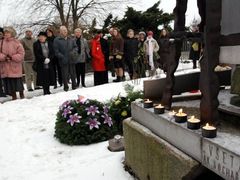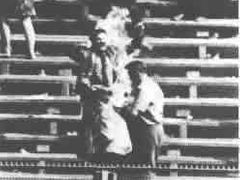Prague - On 16 January 1969, 20-year-old Czech student of philosophy Jan Palach did something which utterly shocked his unsuspecting compatriots and sent shockwaves far beyond the freshly sealed borders of his own country.
In the upper part of Wenceslas Square in the very center of Prague, he used combustible and matches to set himself on fire. Quickly engulfed by flames, he started running down the square.
The act of self-immolation was meant as a protest against the Soviet-led invasion of Czechoslovakia in August of the previous year and Palach's aim was to urge people not to grow passive and indifferent against the totalitarian communist regime which only months before was on the defensive during the peak of the Prague Spring reform movement.
Normalization era
Three days later, he died from severe burns in a hospital.
His funeral on 25 January 1969 turned into a nation-wide protest against the communist regime and Jan Palach soon became a national symbol of resistance against the Soviet occupiers.
In the following weeks, a number of young people followed the sacrificial example of Jan Palach - some of them survived their suicide attempts, others not.
Among the most notorious cases was that of Jan Zajíc who burnt himself to death only a month after Palach's death. And there were more - Evžen Plocek, Josef Hlavatý, Miroslav Malinka and Blanka Nacházelová.
Although Palach planned his suicide as a "wake-up call", the following time period wasn't marked by active resistance, but rather by a "silent agreement" between the unchecked power and the public which resigned en masse and "left for the inner exile", as the saying went.
This grey and yet fascinating era of the so-called normalization has recently been depicted in many Czech films, books and songs.
2008 to be the Year of Palach
Next year will mark the 40th anniversary of Jan Palach´s self-immolation act. On that occasion the Philisophical Faculty of the Charles University in Prague, where Jan Palach was a student, the National Museum and Institute for the Study of Totalitarian Regimes, established only last year, are organizing a major conference and an exhibition to commemorate his legacy.
A two-part book dedicated to Jan Palach will be published in December 2008.
The book - now being prepared by the faculty - will be accompanied by a DVD collection of films about Jan Palach. A series of film screenings and lectures for public will follow.
"The second volume of the book is a unique collection of photographs and documents from the state archives that have been confiscated by the state police," said Petr Blažek, Director of the Department of Security Items Archives at the Ministry of Interior, at a press conference that took place on Wednesday.
"The Secret Police filed a case named Palach shortly after his death. They were checking on people who could have connections abroad and young people who had the potential to commit self-immolation as well," explains Pavel Žáček of the Institute for the Study of Totalitarian Regimes.
The new wave
The twentieth century witnessed many politically-motivated self-immolations. Probably the most famous are those of South Vietnamese Buddhist monks, committed as a protest against religious oppression. But there were many others.
Less known is that Palach wasn't the first to protest against the Soviet invasion of Czechoslovakia in such an extreme way.
In September 1968, less then one month after the Warsaw Pact military intervention, a Polish accountant Ryszard Siwiec set himself on fire during a festival in a stadium in Warsaw. In spite of the act being witnessed by tens of thousands, Polish repressive organs effectively managed to conceal it.
About half a dozen people set themselves alight in 2003 in the Czech Republic in what was to remain an unexplained wave, causing some alarm and even prompting the president to addresss the nation in hopes of preventing further copycat acts at one point.
Three people died and three survived. One of those who died allegedly protested against the war in Iraq. As for the others, authorities were left guessing what might have triggered the desperate act.
No other European country is known to have had a similar phenomenon.












